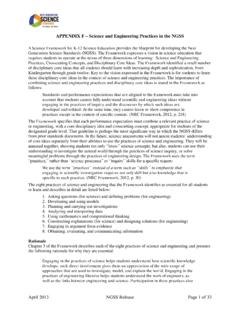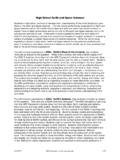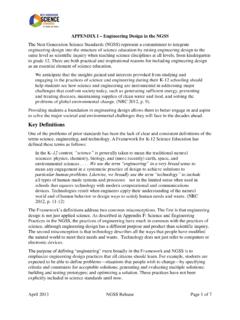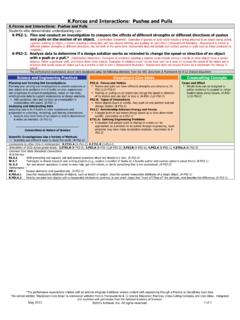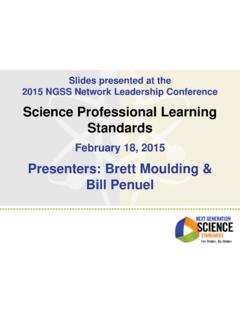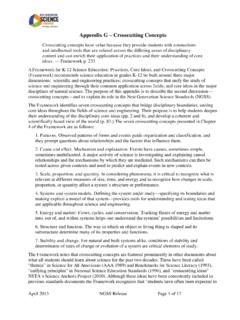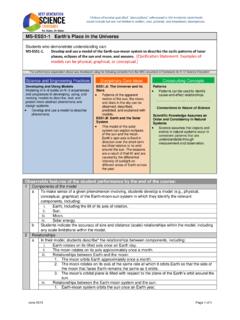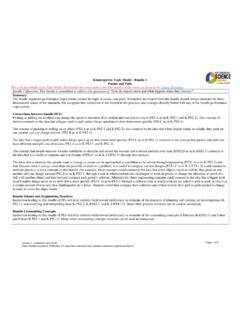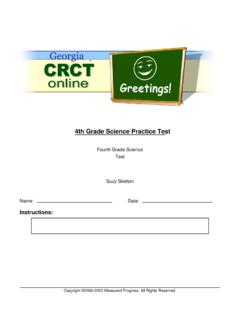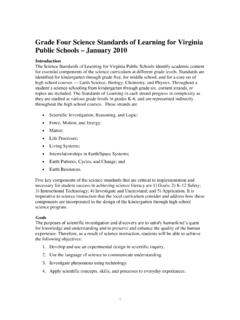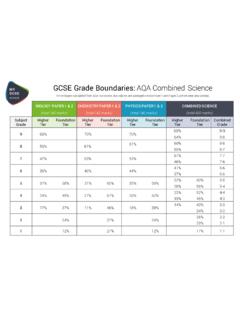Transcription of Third Grade - Next Generation Science Standards
1 Third Grade The performance expectations in Third Grade help students formulate answers to questions such as: What is typical weather in different parts of the world and during different times of the year? How can the impact of weather-related hazards be reduced? How do organisms vary in their traits? How are plants, animals, and environments of the past similar or different from current plants, animals, and environments? What happens to organisms when their environment changes? How do equal and unequal forces on an object affect the object? How can magnets be used? Third Grade performance expectations include PS2, LS1, LS2, LS3, LS4, ESS2, and ESS3 Disciplinary Core Ideas from the NRC Framework. Students are able to organize and use data to describe typical weather conditions expected during a particular season. By applying their understanding of weather-related hazards, students are able to make a claim about the merit of a design solution that reduces the impacts of such hazards.
2 Students are expected to develop an understanding of the similarities and differences of organisms life cycles. An understanding that organisms have different inherited traits, and that the environment can also affect the traits that an organism develops, is acquired by students at this level. In addition, students are able to construct an explanation using evidence for how the variations in characteristics among individuals of the same species may provide advantages in surviving, finding mates, and reproducing. Students are expected to develop an understanding of types of organisms that lived long ago and also about the nature of their environments. Third graders are expected to develop an understanding of the idea that when the environment changes some organisms survive and reproduce, some move to new locations, some move into the transformed environment, and some die. Students are able to determine the effects of balanced and unbalanced forces on the motion of an object and the cause and effect relationships of electric or magnetic interactions between two objects not in contact with each other.
3 They are then able to apply their understanding of magnetic interactions to define a simple design problem that can be solved with magnets. The crosscutting concepts of patterns; cause and effect; scale, proportion, and quantity; systems and system models; interdependence of Science , engineering, and technology; and influence of engineering, technology, and Science on society and the natural world are called out as organizing concepts for these disciplinary core ideas. In the Third Grade performance expectations, students are expected to demonstrate Grade -appropriate proficiency in asking questions and defining problems; developing and using models, planning and carrying out investigations, analyzing and interpreting data, constructing explanations and designing solutions, engaging in argument from evidence, and obtaining, evaluating, and communicating information. Students are expected to use these practices to demonstrate understanding of the core ideas. May 2013 2013 Achieve, Inc. All rights reserved13-PS2 Motion and Stability: Forces and Interactions *The performance expectations marked with an asterisk integrate traditional Science content with engineering through a Practice or Disciplinary Core Idea.
4 The section entitled Disciplinary Core Ideas is reproduced verbatim from A Framework for K-12 Science Education: Practices, Cross-Cutting Concepts, and Core Ideas. Integrated and reprinted with permission from the National Academy of sciences . 3-PS2 Motion and Stability: Forces and Interactions Students who demonstrate understanding can: 3-PS2-1. Plan and conduct an investigation to provide evidence of the effects of balanced and unbalanced forces on the motion of an object. [Clarification Statement: Examples could include an unbalanced force on one side of a ball can make it start moving; and, balanced forces pushing on a box from both sides will not produce any motion at all.] [Assessment Boundary: Assessment is limited to one variable at a time: number, size, or direction of forces. Assessment does not include quantitative force size, only qualitative and relative. Assessment is limited to gravity being addressed as a force that pulls objects down.] 3-PS2-2. Make observations and/or measurements of an object s motion to provide evidence that a pattern can be used to predict future motion.
5 [Clarification Statement: Examples of motion with a predictable pattern could include a child swinging in a swing, a ball rolling back and forth in a bowl, and two children on a see-saw.] [Assessment Boundary: Assessment does not include technical terms such as period and frequency.] 3-PS2-3. Ask questions to determine cause and effect relationships of electric or magnetic interactions between two objects not in contact with each other. [Clarification Statement: Examples of an electric force could include the force on hair from an electrically charged balloon and the electrical forces between a charged rod and pieces of paper; examples of a magnetic force could include the force between two permanent magnets, the force between an electromagnet and steel paperclips, and the force exerted by one magnet versus the force exerted by two magnets. Examples of cause and effect relationships could include how the distance between objects affects strength of the force and how the orientation of magnets affects the direction of the magnetic force.]
6 ] [Assessment Boundary: Assessment is limited to forces produced by objects that can be manipulated by students, and electrical interactions are limited to static electricity.] 3-PS2-4. Define a simple design problem that can be solved by applying scientific ideas about magnets.* [Clarification Statement: Examples of problems could include constructing a latch to keep a door shut and creating a device to keep two moving objects from touching each other.] The performance expectations above were developed using the following elements from the NRC document A Framework for K-12 Science Education: Science and Engineering Practices Asking Questions and Defining Problems Asking questions and defining problems in grades 3 5 builds on grades K 2 experiences and progresses to specifying qualitative relationships. Ask questions that can be investigated based on patterns such as cause and effect relationships. (3-PS2-3) Define a simple problem that can be solved through the development of a new or improved object or tool.
7 (3-PS2-4) Planning and Carrying Out Investigations Planning and carrying out investigations to answer questions or test solutions to problems in 3 5 builds on K 2 experiences and progresses to include investigations that control variables and provide evidence to support explanations or design solutions. Plan and conduct an investigation collaboratively to produce data to serve as the basis for evidence, using fair tests in which variables are controlled and the number of trials considered. (3-PS2-1) Make observations and/or measurements to produce data to serve as the basis for evidence for an explanation of a phenomenon or test a design solution. (3-PS2-2) ---------------------------------------- -------- Connections to Nature of Science Science Knowledge is Based on Empirical Evidence Science findings are based on recognizing patterns. (3-PS2-2) Scientific Investigations Use a Variety of Methods Science investigations use a variety of methods, tools, and techniques. (3-PS2-1) Disciplinary Core Ideas : Forces and Motion Each force acts on one particular object and has both strength and a direction.
8 An object at rest typically has multiple forces acting on it, but they add to give zero net force on the object. Forces that do not sum to zero can cause changes in the object s speed or direction of motion. (Boundary: Qualitative and conceptual, but not quantitative addition of forces are used at this level.) (3-PS2-1) The patterns of an object s motion in various situations can be observed and measured; when that past motion exhibits a regular pattern, future motion can be predicted from it. (Boundary: Technical terms, such as magnitude, velocity, momentum, and vector quantity, are not introduced at this level, but the concept that some quantities need both size and direction to be described is developed.) (3-PS2-2) : Types of Interactions Objects in contact exert forces on each other. (3-PS2-1) Electric, and magnetic forces between a pair of objects do not require that the objects be in contact. The sizes of the forces in each situation depend on the properties of the objects and their distances apart and, for forces between two magnets, on their orientation relative to each other.
9 (3-PS2-3),(3-PS2-4) Crosscutting Concepts Patterns Patterns of change can be used to make predictions. (3-PS2-2) Cause and Effect Cause and effect relationships are routinely identified. (3-PS2-1) Cause and effect relationships are routinely identified, tested, and used to explain change. (3-PS2-3) ---------------------------------------- -------- Connections to Engineering, Technology, and Applications of Science Interdependence of Science , Engineering, and Technology Scientific discoveries about the natural world can often lead to new and improved technologies, which are developed through the engineering design process. (3-PS2-4) Connections to other DCIs in Third Grade : N/A Articulation of DCIs across Grade -levels: (3-PS2-1); (3-PS2-1); (3-PS2-1); (3-PS2-4); (3-PS2-2); (3-PS2-2); (3-PS2-4); (3-PS2-1); (3-PS2-1),(3-PS2-2); (3-PS2-3),(3-PS2-4); (3-PS2-1),(3-PS2-2); (3-PS2-1) Common Core State Standards Connections: ELA/Literacy Ask and answer questions to demonstrate understanding of a text, referring explicitly to the text as the basis for the answers.
10 (3-PS2-1),(3-PS2-3) Describe the relationship between a series of historical events, scientific ideas or concepts, or steps in technical procedures in a text, using language that pertains to time, sequence, and cause/effect. (3-PS2-3) Describe the logical connection between particular sentences and paragraphs in a text ( , comparison, cause/effect, first/second/ Third in a sequence). (3-PS2-3) Conduct short research projects that build knowledge about a topic. (3-PS2-1),(3-PS2-2) Recall information from experiences or gather information from print and digital sources; take brief notes on sources and sort evidence into provided categories. (3-PS2-1),(3-PS2-2) Ask and answer questions about information from a speaker, offering appropriate elaboration and detail. (3-PS2-3) Mathematics Reason abstractly and quantitatively. (3-PS2-1) Use appropriate tools strategically. (3-PS2-1) Measure and estimate liquid volumes and masses of objects using standard units of grams (g), kilograms (kg), and liters (l).

